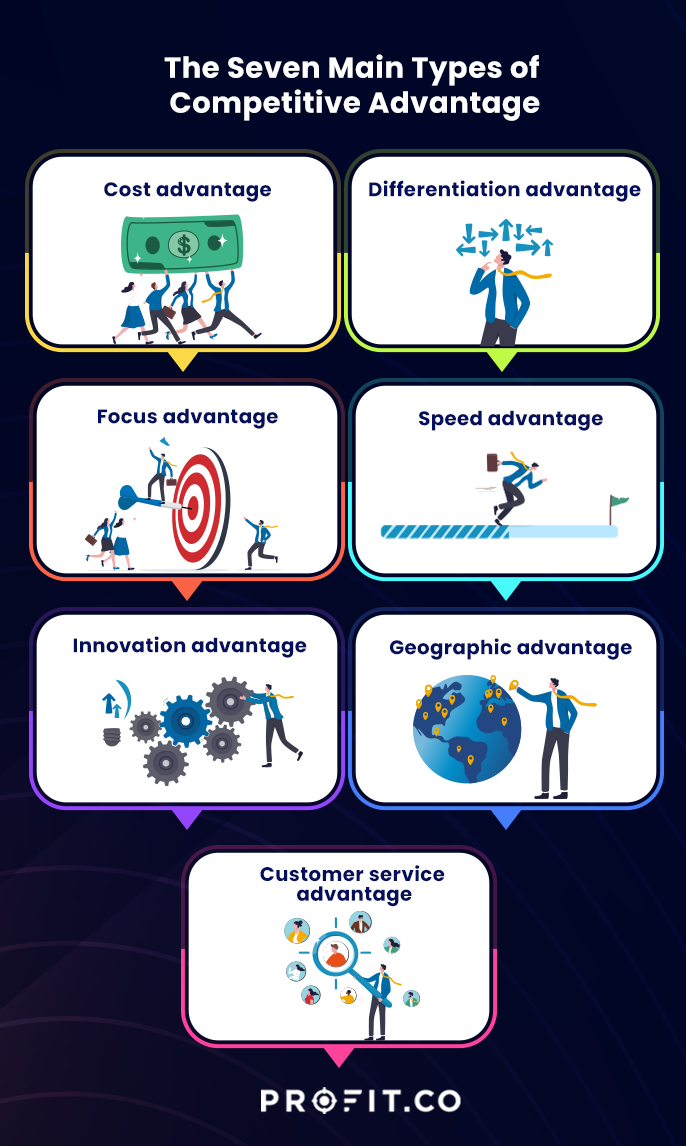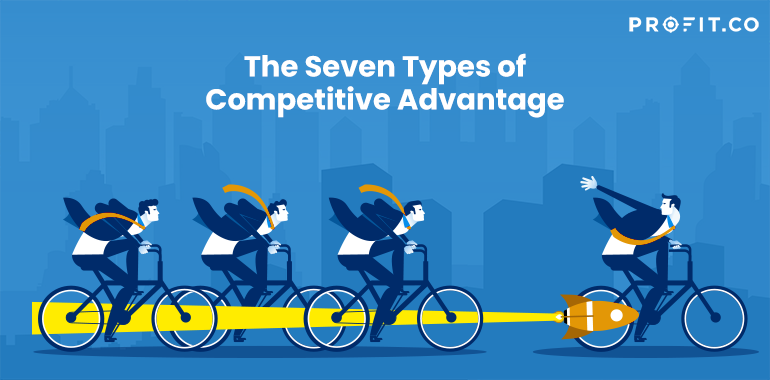In today’s fast-paced environment, businesses can only succeed when they stand out. It is challenging to differentiate themselves and attract and retain customers in a crowded market. Companies must work hard to create value, innovate, introduce distinguishing features, and produce unique offerings.
A competitive advantage allows your company and products/services to create a unique position in the market and establish themselves as the preferred choice for customers. It enables your company to maintain its leadership position in its industry, generate a steady stream of profits over the long term, and promote sustainable growth. Your company can succeed with a sound business strategy by understanding and attaining a competitive advantage in any market.
What is Competitive Advantage?
Competitive advantage is a collection of the unique qualities and attributes of a business or an organization that enables it to outperform its competitors, make customers choose its offerings over the competing products/services, and win a more significant market share.
These attributes can include operational efficiency, product pricing, product positioning, branding, product quality, sales & distribution network, patented technologies and innovations, customer service, customer experience, and any other factor that makes your products or services unique and superior to those of your rivals.
The Fundamental basic of above-average performance in the long run is suitable competitive advantage.
How Does Competitive Advantage Work?
Competitive advantage enables your company to offer some benefits to customers that your competitor does not. It works by making your organization better than your competition.
Do the following to leverage and sustain competitive advantage over the long term.
-
Find the value your products and services offer customers, identify how your offerings meet customer needs, solve their problems and address their pain points.
-
Identify the means to distinguish your products: cost leadership, differentiation and focus.
-
Set clear goals and devise strategies to attain them. Align the employees to those goals and make them work towards the common purpose.
-
Brand your offerings according to the identified strengths and highlight the clear benefits they offer the customers.
-
Continuously create awareness and communicate to customers about those distinguishing features and the value the products and services offer.
-
Utilize performance management software to streamline the process of setting goals, tracking progress, and providing feedback to ensure that your workforce is aligned with your strategic objectives.
-
Identify the factors that can potentially impact your offerings, such as new technological innovations, trends, and competition. For example, integrating automation and AI in eCommerce in areas such as customer support can impact customer experience. If a great customer experience is your competitive advantage, you have to quickly integrate these technologies to make your customer support better, faster, and more efficient.
-
Continuously monitor the target market. Know your customers and their evolving and newly emerging pain points, needs, and problems to remain in sync with your customer base. For example, customer care without chatbots may lead to a longer waiting time for customers to contact customer care executives, especially when your customer base grows beyond a certain level. Identifying this problem and integrating an intelligent chatbot to enable instant response can make the difference between sustaining your competitive advantage in customer support and losing your customers.
-
Keep watch of the emerging competition not only from other companies but also from other products and services or anything else that may offer similar functionality to yours. For example, smartphones have subsumed their functionality, making electronic calculators almost obsolete. Keep your competition at bay by continuously enhancing your products and services with features and functionality in line with the customer’s needs.
Start your OKR journey completely free today to help you gain a competitive advantage
What are the Seven Main Types of Competitive Advantage?
Competitive advantage is all about finding ways to differentiate yourself from competitors and provide unique value to the customers. There are various types of competitive advantages that businesses can attain to stand out from competitors and become successful in the marketplace. The most common types of competitive advantage are the following.
-
Cost advantage
Cost advantage lets you distinguish your products by producing and offering them at a lower cost than your competitors while maintaining acceptable quality standards. You can attain cost advantage by constantly improving efficiency, refining and streamlining the production process, achieving economies of scale, having a successful sales strategy, or cutting costs in various areas. For example, supermarket chains can sell goods for a lower price by procuring them at a lower cost, storing them in high quantities in large warehouses, cutting costs through operational efficiency, and spending less on logistics by owning infrastructure. A small stand-alone local grocery store cannot compete with those companies on price. -
Differentiation advantage
Differentiation advantage involves offering unique products or services of superior quality, more features and benefits, or a stronger brand image, albeit at a premium price. Differentiation can help you build customer loyalty. For example, companies that make cases using composite material for protecting expensive and sensitive equipment such as cameras or musical instruments will charge more than their competitors. However, the assured protection for professionals who often need their gear transported by air cargo will pay a higher price because the quality differentiates the product from the competition. -
Focus Advantage
Focus advantage comes from targeting a specific market segment or a niche. By narrowing your focus to a particular customer group, you can customize your products or services to meet unique needs, solve specific problems and pain points of that group, and stand out from the competitors. It can improve customer loyalty and increase profit margins, provided the target market is big enough or the competition does not pose a significant threat. For instance, unlike Sony, which makes a wide range of electronic equipment and gets involved in diverse, unrelated businesses such as content production and streaming, Nikon makes instruments and equipment that involve precision optics. It gives the company a better focus and the ability to create a loyal fanbase. -
Speed advantage
When you attain a speed advantage, you can be faster in product development, manufacturing, delivery, customer service, or bringing the products to the market. It enables your company to be more agile and respond more quickly to changes in the market than your competitors. For example, the highest level of motor racing requires rapid prototyping, testing, and development. The ones who can bring updates faster throughout the year can make rapid progress and attain success. -
Innovation advantage
Innovation allows you to develop new products and services or introduce new business models that disrupt existing markets or create new ones. Innovation advantage can help you stay ahead of competitors and create new opportunities for sustainable growth. For example, Apple replaced off-the-shelf CPU components with their custom-designed silicon to achieve path-breaking energy efficiency and processing power with minimal cooling requirements in their computers. -
Geographic advantage
Geographic advantage involves having a strategic location that gives you easier access to resources, suppliers, or customers. It can include proximity to raw materials, rail routes, ports, transportation hubs, access to natural resources, cheap electricity, etc., or a large customer base.For example, if US-based companies decide to move electronics manufacturing out of China, an alternative manufacturing location would be India. India has all the required facilities and a large customer base, allowing the companies to procure components locally, get low-cost electricity and Human Resources locally, set up factories near ports, and sell the products in large numbers locally as well.
-
Customer service advantage
A customer service advantage involves superior customer service and support. You can gain it by enabling faster response times, personalized support, diverse customer support channels, or better communication. Customer service advantage helps businesses build strong relationships with customers and create a loyal customer base. For example, companies like Amazon provide 24/7 support, chatbots for instant response and narrowing down the issue to a specific problem, quick access to customer support executives, easy returns and refunds to make the customer experience better, and customer support faster and more personalized.

Competitive Advantage Framework
The competitive advantage framework enables businesses to analyze their industry and understand its competitive dynamics. It helps them identify their sources of competitive advantage with which they can differentiate their products from those of the competitors, develop a strategic plan for achieving their goals, succeed in the marketplace, and achieve long-term growth. Michael Porter, a leading expert in business strategy, designed it.
The competitive advantage framework consists of the following three key elements.
-
Industry analysis
In the first phase, you have to carefully analyze the structure and the current state of the industry in which your business operates. It involves considering various factors, including how intense the competition is, how much bargaining power the suppliers and customers have, and the possible threats posed by new entrants and substitutes. For instance, a mobile phone manufacturer would analyze the cut-throat margins, varying cost of components proportional to the number of units ordered by different competitors, rate of product development year-on-year, features and specifications offered by various competitors, etc. By understanding the industry dynamics, you can identify opportunities and threats you may face. -
Generic strategies
In the second phase, you can identify generic strategies that can help you gain a competitive advantage. This phase mainly consists of cost leadership, differentiation, and focus. For example, if you run a supermarket, you will be selling different categories of products, and you can eliminate focus advantage from it. You could attain a differentiation advantage by serving customers better, providing value-added services such as BOPIS, or offering a great loyalty program. You could gain a cost leadership advantage if you have the bargaining power to negotiate prices better with the suppliers; if so, you can sell for lower prices than your competition. -
Value chain analysis
Value chain analysis involves breaking down your business into its smaller component activities and identifying the value they have created at each stage. This highlights the areas that provide you with the scope to reduce costs or create more value.For instance, in the abovementioned supermarket, you can analyze the primary activities such as the following.
-
Inbound logistics: Receiving and storing products, managing supplier relationships, negotiating prices, etc.
-
Operations: Restocking shelves, managing inventory, displaying products, etc.
-
Outbound logistics: Checkout process, product delivery, customer service, etc.
-
Marketing and sales: Marketing campaigns, digital advertising, customer relationships, retaining customers, etc.
-
Service: Customer support, helping customers find products, answering questions, handling complaints, etc.,
You can also analyze the following support activities.
-
Procurement: Sourcing products, negotiating prices and terms, and managing supplier relationships.
-
Technology development: Improving operations and customer experience through investments in new technologies and business systems.
-
Human resources: Hiring, training employees, developing compensation and benefits, implementing employee welfare programs, and managing employee relations.
-
Infrastructure: Maintaining, managing, and expanding the infrastructure of the supermarket.
What is a Sustainable Competitive Advantage?
A sustainable competitive advantage is a long-term advantage that goes beyond short-term benefits. It enables your business to outperform its competitors consistently, maintain market leadership and achieve success over a long time. To maintain a sustainable competitive advantage, you should keep building on your strengths, invest in everything that differentiates you from the competition, and remain agile to stay ahead of the changes in the market or the industry.
4 Key criteria to build a sustainable competitive advantage
A competitive advantage should meet the following requirements to remain sustainable.
-
Valuable: A competitive advantage should offer your customers tangible benefits and real value. It should solve their problems, address their needs, and improve their lives. It may benefit the customers through better quality, lower costs or greater convenience.
-
Rare: Your competitive advantage should be one-of-a-kind or challenging to replicate. Otherwise, the competitors may easily copy your competitive advantage, eroding its value over time.
-
Inimitable: Your differentiating factors should be virtually impossible to imitate or replicate even if the competitors understand their importance and want to copy them. Competitive advantage will be inimitable if it has protection in the form of intellectual property, requires specialized skills or knowledge, or requires unique resources to replicate, which the competitors cannot access.
-
Non-substitutable: Your competitive advantage should make you extremely difficult to substitute with alternatives, i.e., with a non-substitutable competitive advantage, even if competitors offer similar products or services to yours, the customers would not prefer to switch to competing brands/products/services, due to customer loyalty, brand recognition, or network effects.
5 steps to create a sustainable competitive advantage
The following steps help to identify your competitive advantage.
-
Identify and define your target market, select your customer base, determine their needs, wants, pain points, or challenges, and find ways to address them.
-
Conduct a competitive analysis, and identify and understand your competitors, their strengths and weaknesses, and their offerings. Analyze how they position themselves in the market. Look for opportunities to differentiate yourself from them.
-
Follow SWOT analysis best practices by identifying and determining your strengths, weaknesses, opportunities, and threats that may impact your business. Understand your differentiating factors, unique capabilities, and competitive advantages.
-
Identify and develop a clear and compelling value proposition that sets you apart from your competition, and highlight the unique benefits you offer your customers and how you address their specific needs or pain points.
-
Leverage customer feedback to identify what your customers like and value most about your business, gain insights on improving your offerings, identify areas where you excel, and find opportunities to distinguish yourself from the competition.
FAQs
-
What is a competitive advantage?
A competitive advantage is a collection of factors or qualities that allow an organization to outperform its competitors and achieve superior results. It results from a unique combination of capabilities, resources, and market positioning. -
What are the three types of competitive advantage?
The three types of competitive advantage are cost, differentiation, and focus. You can gain a cost advantage by producing goods or services at a lower cost than competitors, a differentiation advantage by offering unique, differentiating features compared to the competitors, and a focused advantage by focusing on a specific market segment or niche with specialized products or services. -
What is an example of competitive advantage?
Toyota’s lean manufacturing system is an example of competitive advantage. The system focuses on reducing waste and maximizing efficiency in the production process. It enables Toyota to produce high-quality cars at a lower cost. -
What are the five factors of competitive advantage?
The five factors of competitive advantage are the following.
-
Innovation
-
Quality
-
Efficiency
-
Customer responsiveness
-
Brand reputation
-
Conclusion
A competitive advantage allows your organization to sustain and grow in an aggressive market. Standing out is imperative, and the seven types of competitive advantage allow individuality and value for any organization. Utilizing the tools and techniques outlined in this article, your organization will thrive despite market conditions.

